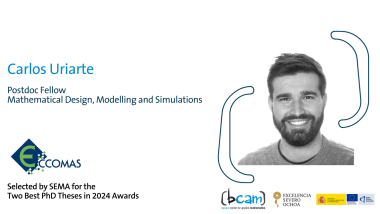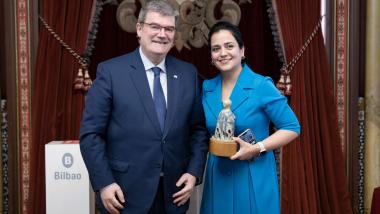- La defensa tendrá lugar en el Departamento de Ingeniería de Comunicaciones de la Escuela de Ingeniería de Bilbao
Izaskun Oregi se licenció en Física de la Universidad del País Vasco en 2011. En 2012 obtuvo un Máster en Física de Redes Complejas en la Universidad Politécnica de Madrid, y en 2016 un Máster en Ingeniería Matemática en la Universidad Complutense de Madrid. Actualmente trabaja como investigadora en el departamento de análisis y optimización de datos de Tecnalia. Sus principales áreas de interés son la clasificación de series temporales, la minería de series temporales de flujos y el aprendizaje de máquinas adversarias.
Su tesis doctoral,
Advances on Time Series Analysis using Elastic Measures of Similarity, ha sido supervisada por el Dr. Javier Del Ser (BCAM-Tecnalia) y el Dr. Aritz Pérez (BCAM).
La defensa tendrá lugar el
jueves 23 de julio a las 11:00 horas en el Departamento de Ingeniería de Comunicaciones de la Escuela de Ingenieros de Bilbao.
En nombre de todos los miembros del BCAM, queremos desear a Izaskun la mejor de las suertes en la defensa de su próxima tesis.
[idea]
PhD thesis title: Advances on Time Series Analysis using Elastic Measures of Similarity
A sequence is a collection of data instances arranged in a structured manner. When this arrangement is held in the time domain, sequences are instead referred to as time series. As such, each observation in a time series represents an observation drawn from an underlying process, produced at a specific time instant. However, other type of data indexing structures, such as space- or threshold-based arrangements are possible. Data points that compose a time series are often correlated with each other. To account for this correlation in data mining tasks, time series are usually studied as a whole data object rather than as a collection of independent observations. In this context, techniques for time series analysis aim at analyzing this type of data structures by applying specific approaches developed to leverage intrinsic properties of the time series for a wide range of problems, such as classification, clustering and other tasks alike.
The development of monitoring and storage devices has made time series analysis proliferate in numerous application fields, including medicine, economics, manufacturing and telecommunications, among others. Over the years, the community has gathered efforts towards the development of new data-based techniques for time series analysis suited to address the problems and needs of such application fields. In the related literature, such techniques can be divided in three main groups: feature-, model- and distance-based methods. The first group (feature-based) transforms time series into a collection of features, which are then used by conventional learning algorithms to provide solutions to the task under consideration. In contrast, methods belonging to the second group (model-based) assume that each time series is drawn from a generative model, which is then harnessed to elicit knowledge from data. Finally, distance-based techniques operate directly on raw time series. To this end, these methods resort to specially defined measures of distance or similarity for comparing time series, without requiring any further processing. Among them, elastic similarity measures (e.g., dynamic time warping and edit distance) compute the closeness between two sequences by finding the best alignment between them, disregarding differences in time, and thus focusing exclusively on shape differences.
This Thesis presents several contributions to the field of distance-based techniques for time series analysis, namely: i) a novel multi-dimensional elastic similarity learning method for time series classification; ii) an adaptation of elastic measures to streaming time series scenarios; and iii) the use of distance-based time series analysis to make machine learning methods for image classification robust against adversarial attacks. Throughout the Thesis, each contribution is framed within its related state of the art, explained in detail and empirically evaluated. The obtained results lead to new insights on the application of distance-based time series methods for the considered scenarios, and motivates research directions that highlight the vibrant momentum of this research area.[/idea]




